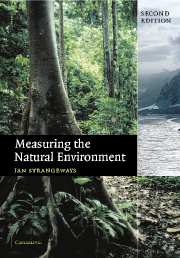Book contents
- Frontmatter
- Contents
- Acknowledgements
- 1 Basics
- 2 Radiation
- 3 Temperature
- 4 Humidity
- 5 Wind
- 6 Barometric pressure
- 7 Evaporation
- 8 Precipitation
- 9 Soil moisture and groundwater
- 10 Rivers and lakes
- 11 Data logging
- 12 Telemetry
- 13 Visibility
- 14 Clouds
- 15 Lightning
- 16 The upper atmosphere
- 17 The oceans
- 18 Cold regions
- 19 Remote sensing
- 20 Atmospheric composition
- 21 Forward look
- Appendix: abbreviations and acronyms
- Index
- References
4 - Humidity
Published online by Cambridge University Press: 05 July 2014
- Frontmatter
- Contents
- Acknowledgements
- 1 Basics
- 2 Radiation
- 3 Temperature
- 4 Humidity
- 5 Wind
- 6 Barometric pressure
- 7 Evaporation
- 8 Precipitation
- 9 Soil moisture and groundwater
- 10 Rivers and lakes
- 11 Data logging
- 12 Telemetry
- 13 Visibility
- 14 Clouds
- 15 Lightning
- 16 The upper atmosphere
- 17 The oceans
- 18 Cold regions
- 19 Remote sensing
- 20 Atmospheric composition
- 21 Forward look
- Appendix: abbreviations and acronyms
- Index
- References
Summary
One morning the view was singularly clear, the distant mountains being projected with the sharpest outline, on a heavy bank of dark blue clouds. Judging from the appearance, and from similar cases in England, I supposed the air was saturated with moisture. The fact, however, turned out quite the contrary. The hygrometer gave a difference of 29.6 degrees (F), between the temperature of the air, and the point at which dew was precipitated. This difference was nearly double that which I had observed on the previous mornings. This unusual degree of atmospheric dryness was accompanied by continual flashes of lightning. Is it not an uncommon case, thus to find a remarkable degree of aerial transparency with such a state of weather?
Charles Darwin Voyage of the Beagle (Cape de Verd Islands).The variable
Just as air, warmed by contact with the ground, is transferred into the atmosphere by processes of diffusion, turbulence and convection, so too is the water vapour produced by evaporation. The ratio in which the net radiative energy is divided between heating the atmosphere, heating the ground and evaporating water is dependent on many factors, such as the amount of water actually available, the nature of the ground and the type of vegetation. Knowing the rate of evaporation of water is useful information in hydrology, meteorology and agriculture, but it is difficult to measure. However, the amount of water vapour in the air, i.e. the air’s humidity, is easier to measure and this chapter looks at how it is done; Chapter 7 addresses the more difficult problem of how evaporation rates are measured.
- Type
- Chapter
- Information
- Measuring the Natural Environment , pp. 53 - 68Publisher: Cambridge University PressPrint publication year: 2003



